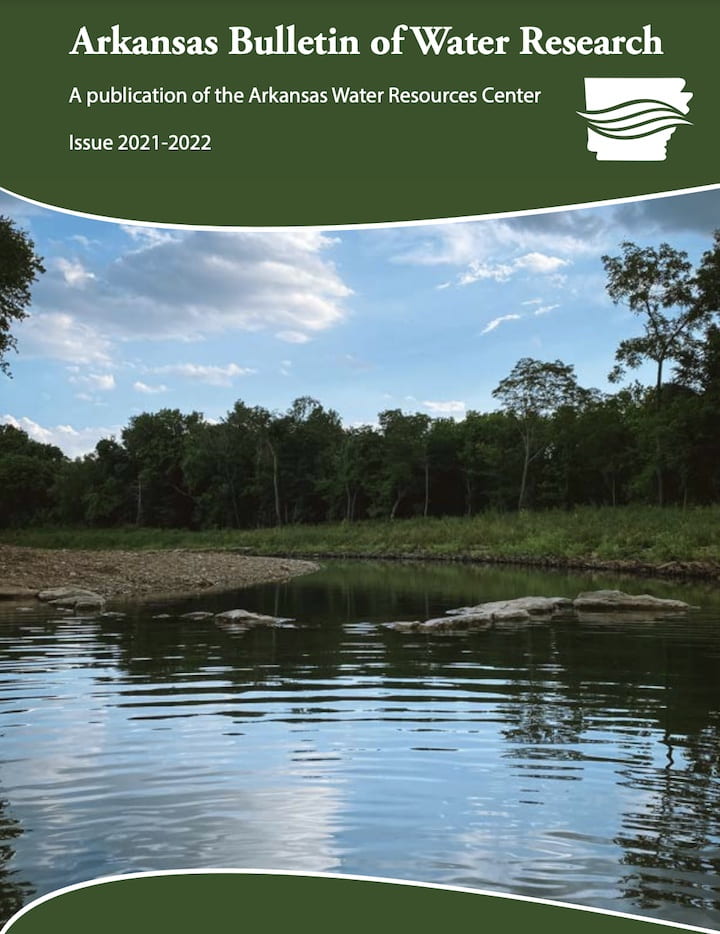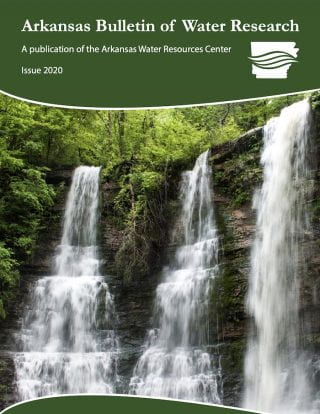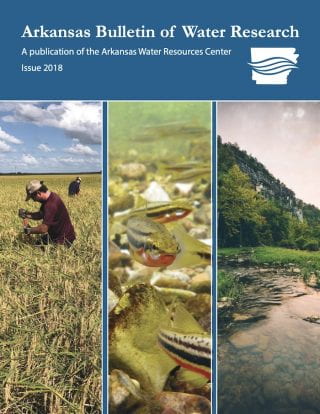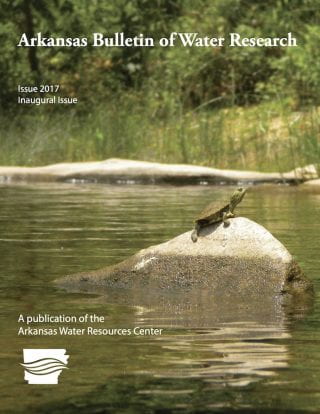Arkansas Bulletin of Water Research
The Arkansas Bulletin of Water Research is a publication of the Arkansas Water Resources Center (AWRC). This bulletin is produced in an effort to share water research relevant to Arkansas water stakeholders in an easily searchable and aesthetically engaging way.
The submission of a paper to this bulletin is approproiate for topics all related to water resoucers, by anyone conducting water research or investigations. This includes but is not limited to unviersity researchers, consulting firms, watershed groups, and other agencies.
Issue 2021/2022
 Cover & Table of Contents
Cover & Table of Contents
Page 1 – Assessing Water Quality and Biological Impacts of Nonpoint Source Pollution in the Eleven Point and Lower Black River Watersheds
Page 9 – Utilization of Biodegradable Hydroponic Growth Media as a Carbon Source for Greenhouse Wastewater Denitrification
Page 17 – Nitroxyl – The Missing Link in NDMA Formation in Chloramine Systems
Page 22 – In Situ Cyanotoxin Mitigation: Net Design to Enhance Photocatalytic Degradation Mechanisms
Page 27 – Integrated Electrocoagulation/Ultrafiltration-Membrane Distillation-Crystallization for Treating Hydraulic Fracturing Produced Water
Page 38 – Is Rice as Effective as Barley Straw or Hydrogen Peroxide in Inhibiting Cyanobacterial Blooms and Reducing Microcystin Concentrations?
Page 43 – Mechanisms, Kinetics and Toxicity of Microcystin-LR Biodegradation by Free and Immobilized Enzymes
Page 49 – Understanding Microcystin Occurrence and Predictors at Lake Fayetteville
FULL ISSUE – Arkansas Bulletin of Water Research Issue 2021-2022
Issue 2019/2020
 – Introduction to the Arkansas Bulletin of Water Research, reprinted
– Introduction to the Arkansas Bulletin of Water Research, reprinted
– An In Situ Approach to Harmful Algal Blooms: Simultaneous Treatment of Cyanobacteria and Cyanotoxins in Natural Water Sources Using Catalytic Nanoparticle-Fiber Nets
– Legacy Sediment Bound Phosphorus and Low Macroinvertebrate Diversity in Agricultural Catchments Suggests a Long Road to Recovery
– Quantifying Flow Sources and their Impacts on Water Quality in Forested Ozark Streams
– Herbicide Mitigation Potential of Tailwater Recovery Systems in the Cache River Critical Groundwater Area [Updated from 2018]
– Groundwater and Time Preference Elicitation: Estimating the Value of Market and Non-Market Groundwater Services Over Time
Issue 2018
 Page 1 – Cover & Table of Contents
Page 1 – Cover & Table of Contents
Page 5 – Introduction to the Arkansas Bulletin of Water Research, reprinted
Page 7 – Comparative Microbial Community Dynamics in a Karst Aquifer System and Proximal Surface Stream in Northwest Arkansas
Page 13 – Investigating Impact of Lead Service Lines in Drinking Water Distribution Systems at the City of Tulsa
Page 18 – Characterization of Nutrient Sources, Transport Pathways, and Transformations Using Stable Isotope and Geochemical Tools in the Big Creek Watershed of Northwest Arkansas
Page 28 – Combined Application of Nutrient Manipulation and Hydrogen Peroxide Exposure to Selectively Control Cyanobacteria Growth and Promote Eukaryote Phytoplankton Production in Aquaculture Ponds
Page 38 – Herbicide Mitigation Potential of Tailwater Recovery Systems in the Cache River Critical Groundwater Area
Page 44 – Assessment of Strategies to Address Future Irrigation Water Shortage in the Arkansas Delta
Page 50 – Tracking the Growth of On-Site Irrigation Infrastructure in the Arkansas Delta with Remote Sensing Analysis
Page 58 – Regionalizing Agricultural Field Evapotranspiration Observations
Page 64 – Educating the Masses Using Mass Media for Stormwater Pollution Prevention
– Issue 2018 Covington Microbial community dynamics between karst and surface water connections
– Issue 2018 Hays and Sokolosky Characterizing nutrient dynamics using isotopes Big Creek watershed
– Issue 2018 Huang Knapp Strategies to address future irrigation water shortages in Arkansas delta
– Issue 2018 Introduction
– Issue 2018 Kovacs and West Growth of onsite irrigation infrastructure in Arkansas delta
– Issue 2018 Ouei Educating the masses with social media for stormwater pollution prevention
– Issue 2018 Runkle Regionalizing agricultural field evapotranspiration observations
– Issue 2018 Sinha Hydrogen peroxide to control cyanobacteria growth
– Issue 2018 Zhang and Belcher Lead service lines in drinking water systems
Issue 2017
 Page 1 – Cover & Table of Contents
Page 1 – Cover & Table of Contents
Page 5 – Introduction to the Arkansas Bulletin of Water Research
Page 7 – Partitioning Rice Field Evapotranspiration into Evaporation and Transpiration Components
Page 13 – Stoneroller Fish (Campostoma spp.) Influence on Dose-Response Relationship Between Nutrients and Algae in Summer 2016 and Winter 2017
Page 20 – Biological and Ecological Consequences of Sub-Lethal Ion Concentrations on Microbial and Macroinvertebrate Detritivores
Page 28 – Investigating Fate of Engineered Nanoparticles in Wastewater Biofilms
– Issue 2017 Entrekin Sub lethal ion concentrations on detritivores
– Issue 2017 Evans White and Sayre Stonerollers relationship with nutrients algae
– Issue 2017 Introduction
– Issue 2017 Runkle Partitioning rice field ET components
– Issue 2017 Zhang and Walden Fate of engineered nanoparticles in wastewater biofilms
Instructions for Authors
Download a PDF copy of AWRC’s Instructions for Authors
Aim and Scope
The Arkansas Bulletin of Water Research was developed to allow anyone conducting research relevant to Arkansas water issues to publish their results, making them available to stakeholders and other researchers throughout the State. The Bulletin is a great avenue to publish results that might not stand alone in a national or international journal, yet are extremely valuable to stakeholders in Arkansas.
The aim of this bulletin is to communicate applied research findings that people of various specialties can understand. Therefore, papers should be written in a relatively casual way, like a conversation with the reader.
“The most important rule: write for the busy reader who is easily distracted.” This statement comes from a great reference on scientific writing,
Griffies, S.M., W.A. Perrie, and G. Hull. Elements of Style for Writing Scientific Journal Articles. 2013. Elsevier.
Another nice reference to scientific writing is,
Mackay, R.J. Writing Readable Papers: How to Tell a Good Story. Reprinted from the Bulletin of the North American Benthological Society 12(3):381-388; 1995.
Format Guidelines
- When typing the title and body of the paper:
- Use font Calibri (body) 11 point.
- Bold title and section headers.
- Section sub-headers should be bold italic
- Section sub-sub-headers should be italic
- Center the title and PIs; fully justify body text.
- Report units in metric and other standard scientific units. An exception is when reporting discharge, CFS (cubic feet per second) is acceptable.
- Report units as superscripts, not backslashes (ex. mg m‐2 d‐1 is correct).
- When referring to tables and figures in the text, spell out “Table” and “Figure”.
- When referencing others’ work, format such as, (Keenan et al., 2015; Simone and Keenan, 2016). See the References section below for more details.
- Papers should be 2,500 words or less, not counting references, tables, and figures.
- Do NOT place tables and figures within the text.
- When creating tables:
- Use Microsoft Excel to create tables; text should be 9-point Calibri font; footnotes should be included under the table; each table should be saved as its own Excel file, named as, “Simone-Table-1”, for example, where Simone is the primary author’s last name.
- Table captions should be included after the References section; captions should be 9-point Calibri font and fully justified.
- Tables should be able to stand alone, meaning the caption should succinctly include all the information necessary for the reader to understand the table.
- When creating figures:
- The Bulletin will be published online and can display figures (graphs, pictures) in color.
- Figures should be emailed as individual image files (jpg, emf, png, tif), named as, “Simone-Figure-1”, for example, where Simone is the primary author’s last name.
- Graphs should be saved as at least 300 DPI, and pictures at least 72 DPI; creating content in PowerPoint is not preferred due to low-quality resolution once it’s saved as an image file; rather, using vector‐based software such as Adobe Illustrator is preferred. Many FREE alternatives to Adobe Illustrator exist. If PowerPoint is necessary, be sure that when the figure is inserted into a word document and sized appropriately it does not appear pixelated.
- Captions should come after the references section and be in 9-point Calibri font and fully justified.
- Make sure that axes titles and labels are large enough that when the figure is scaled down to fit the page, labels will be readable. For example, if you create a figure in SigmaPlot, you may need to use a font size of 14 or 18 point.
- Figures should be able to stand alone, meaning the caption should succinctly include all the information necessary for the reader to understand the figure.
Parts of the Paper
The paper should be 2,500 words or less, not counting references, tables, and figures.
Title
Short Title
A title of 90 characters or less (including spaces).
Author Information
Include author first and last name, affiliation, and department of affiliation (if applicable). Also, identify the corresponding author if there is more than one author.
Abstract
In 250 words or less, summarize the report. Include the basic problem, why it’s important to Arkansas, what’s the research question, what’s the objective(s) of the research, a brief description of methods, specific results, and conclusions or recommendations to water managers.
Key Points
Include 3 to 5 bulleted statements of 25 words or less that concisely describe the overall importance, applicability, or impacts of the research.
Introduction
This is where you really get to capture the reader’s attention and set up the story you’re about to tell. The introduction should start fairly broadly by describing the general topic and problem. References to the literature should be used to describe what’s already known about the topic, but also to show what the knowledge gap is that your research will address.
As you convey the basic facts and importance of the topic, the introduction should start to narrow the focus to a more specific problem, location, or mechanism. This should then lead to specific objectives and hypotheses. This is also a great time to emphasize to the reader how the research can be applied by others…what’s the big impact? How might this work be used by water resource specialists in Arkansas and perhaps around the region and country?
The introduction should be 3 to 5 paragraphs, each of 3 to 5 sentences.
Methods
The methods should provide adequate detail about the project such that someone else could repeat it. Include information about the study design, location or site description, sampling procedure, data collection, laboratory analyses, and statistical analyses.
Results and Discussion
What were the major or important findings that help to answer your research question? Be sure to include tables, figures, and statistical results. How do you interpret these findings, and how do they fit or not fit into the existing body of knowledge?
Conclusions
What do you want the reader to take away? What are your recommendations to water resource specialists? What are the benefits to Arkansas; also the region and the country, if applicable? This is the section where you should emphasize how your research can be applied by others to address pressing water problems in Arkansas.
Acknowledgments
This section allows you to recognize funding support and other assistance. It’s also a place to include any disclaimers on behalf of your funding support if applicable.
References
Format the references based on the following guidelines.
- Alphabetical order: Arrange alphabetically by surnames. Single‐author references of a given individual should precede multiple‐author articles where the individual is the primary author. Alphabetize entries with the same first author by subsequent coauthors, then by year.
- Authors: List the authors by the last name followed by initials (Welch, F.M.). For references with more than one author, only the first author’s name is inverted. (Welch, F.M., I. Summers, and C.L. Hayden).
- Titles: Capitalize all major words in the title.
- Journal titles: Write out the entire name of the journal.
- Citation style for journal articles: First author, second author, and third author. Year. Title of the article. Journal Title Vol.(issues): pages. For articles with more than 5 authors, use ellipses after the 4th author and then provide the final author’s name.
Tyrrel, S. F., and J.N. Quinton. 2003. Overland Flow Transport of Pathogens from Agricultural
Land Receiving Faecal Wastes. Journal of Applied Microbiology 94: 87–93.
Homer, C. G., J. A. Dewitz, L. Yang, S. Jin, … and K. Megown. 2015. Completion of 2011
National Land Cover Database for the conterminous United States‐representing a decade of
land cover change information. Photogrammetric Engineering and Remote Sensing 81: 345–354. - Citation style for an article in press: Use the current year as the date. If the article has been posted online before being formally published, include the DOI.
Author. Year. Article title. Journal Title DOI number (in press). - Citation for a book:
Author(s). Publication year. Book Title (and edition if applicable). Publisher. - Citation style for a webpage: include the URL and the date accessed.
The United States Environmental Protection Agency (USEPA) 2016. National Summary of Impaired
Waters and TMDL Information. U.S. Environmental Protection Agency, Washington DC.
http://www.iaspub.epa.gov/waters10/attains_nation_cy.control?p_report_type=T#causes_
303d. (accessed July 2016). - Citation for software:
SAS Institute. 1994. The SAS system for Windows. Release 6.10. SAS Inst., Cary, NC.
Advice to Authors
Some scientists are great communicators, and some scientists struggle with how to convey information to the public. The goal of this bulletin is to provide information that’s easy for people to understand who are from a range of disciplines. Try to use straight forward and simple words and sentences. For example, use the word “showed”, not “demonstrated” to simplify the text. The writing should be interesting and conversational, and complex jargon should be left out..
This bulletin is designed to be a valuable resource to water specialists who have to make some tough decisions on how to address our most pressing water resource problems. It will also provide valuable reference material for current and future researchers focused on water issues in Arkansas. As you are writing the paper, frequently ask yourself, “how can results of this work help stakeholders in Arkansas.”
Paper Submission
Email your submission materials (document file, files for tables and figures) to haggard@uark.edu. Send a follow up email to ensure successful delivery, since file sizes might cause a failure to receive the email.
Review Procedures
Papers will be reviewed by the editors of the Bulletin or solicited technical reviewers, who will determine if the paper should be published with minor revisions, revised and resubmitted, or rejected. Any external technical review will be blind, where the submitting author will not know who reviews their paper. The editors will provide a written review with comments. The author will be expected to address comments in the paper and in a response to reviewer comments.
Download a PDF copy of AWRC’s Instructions for Authors
Editors

Dr. Brian E. Haggard, Director
Phone: 479-575-2879
Email: haggard@uark.edu
Issue 2021/2022
Issue 2021/2022
 Cover & Table of Contents
Cover & Table of Contents
Page 1 – Assessing Water Quality and Biological Impacts of Nonpoint Source Pollution in the Eleven Point and Lower Black River Watersheds
Page 9 – Utilization of Biodegradable Hydroponic Growth Media as a Carbon Source for Greenhouse Wastewater Denitrification
Page 17 – Nitroxyl – The Missing Link in NDMA Formation in Chloramine Systems
Page 22 – In Situ Cyanotoxin Mitigation: Net Design to Enhance Photocatalytic Degradation Mechanisms
Page 27 – Integrated Electrocoagulation/Ultrafiltration-Membrane Distillation-Crystallization for Treating Hydraulic Fracturing Produced Water
Page 38 – Is Rice as Effective as Barley Straw or Hydrogen Peroxide in Inhibiting Cyanobacterial Blooms and Reducing Microcystin Concentrations?
Page 43 – Mechanisms, Kinetics and Toxicity of Microcystin-LR Biodegradation by Free and Immobilized Enzymes
Page 49 – Understanding Microcystin Occurrence and Predictors at Lake Fayetteville
Issue 2019/2020
Issue 2019/2020
 – Introduction to the Arkansas Bulletin of Water Research, reprinted
– Introduction to the Arkansas Bulletin of Water Research, reprinted
– An In Situ Approach to Harmful Algal Blooms: Simultaneous Treatment of Cyanobacteria and Cyanotoxins in Natural Water Sources Using Catalytic Nanoparticle-Fiber Nets
– Legacy Sediment Bound Phosphorus and Low Macroinvertebrate Diversity in Agricultural Catchments Suggests a Long Road to Recovery
– Quantifying Flow Sources and their Impacts on Water Quality in Forested Ozark Streams
– Herbicide Mitigation Potential of Tailwater Recovery Systems in the Cache River Critical Groundwater Area [Updated from 2018]
– Groundwater and Time Preference Elicitation: Estimating the Value of Market and Non-Market Groundwater Services Over Time
Issue 2018
Issue 2018
 Page 1 – Cover & Table of Contents
Page 1 – Cover & Table of Contents
Page 5 – Introduction to the Arkansas Bulletin of Water Research, reprinted
Page 7 – Comparative Microbial Community Dynamics in a Karst Aquifer System and Proximal Surface Stream in Northwest Arkansas
Page 13 – Investigating Impact of Lead Service Lines in Drinking Water Distribution Systems at the City of Tulsa
Page 18 – Characterization of Nutrient Sources, Transport Pathways, and Transformations Using Stable Isotope and Geochemical Tools in the Big Creek Watershed of Northwest Arkansas
Page 28 – Combined Application of Nutrient Manipulation and Hydrogen Peroxide Exposure to Selectively Control Cyanobacteria Growth and Promote Eukaryote Phytoplankton Production in Aquaculture Ponds
Page 38 – Herbicide Mitigation Potential of Tailwater Recovery Systems in the Cache River Critical Groundwater Area
Page 44 – Assessment of Strategies to Address Future Irrigation Water Shortage in the Arkansas Delta
Page 50 – Tracking the Growth of On-Site Irrigation Infrastructure in the Arkansas Delta with Remote Sensing Analysis
Page 58 – Regionalizing Agricultural Field Evapotranspiration Observations
Page 64 – Educating the Masses Using Mass Media for Stormwater Pollution Prevention
– Issue 2018 Covington Microbial community dynamics between karst and surface water connections
– Issue 2018 Hays and Sokolosky Characterizing nutrient dynamics using isotopes Big Creek watershed
– Issue 2018 Huang Knapp Strategies to address future irrigation water shortages in Arkansas delta
– Issue 2018 Introduction
– Issue 2018 Kovacs and West Growth of onsite irrigation infrastructure in Arkansas delta
– Issue 2018 Ouei Educating the masses with social media for stormwater pollution prevention
– Issue 2018 Runkle Regionalizing agricultural field evapotranspiration observations
– Issue 2018 Sinha Hydrogen peroxide to control cyanobacteria growth
– Issue 2018 Zhang and Belcher Lead service lines in drinking water systems
Issue 2017
Issue 2017
 Page 1 – Cover & Table of Contents
Page 1 – Cover & Table of Contents
Page 5 – Introduction to the Arkansas Bulletin of Water Research
Page 7 – Partitioning Rice Field Evapotranspiration into Evaporation and Transpiration Components
Page 13 – Stoneroller Fish (Campostoma spp.) Influence on Dose-Response Relationship Between Nutrients and Algae in Summer 2016 and Winter 2017
Page 20 – Biological and Ecological Consequences of Sub-Lethal Ion Concentrations on Microbial and Macroinvertebrate Detritivores
Page 28 – Investigating Fate of Engineered Nanoparticles in Wastewater Biofilms
– Issue 2017 Entrekin Sub lethal ion concentrations on detritivores
– Issue 2017 Evans White and Sayre Stonerollers relationship with nutrients algae
– Issue 2017 Introduction
– Issue 2017 Runkle Partitioning rice field ET components
– Issue 2017 Zhang and Walden Fate of engineered nanoparticles in wastewater biofilms
Instructions
Instructions for Authors
Download a PDF copy of AWRC’s Instructions for Authors
Aim and Scope
The Arkansas Bulletin of Water Research was developed to allow anyone conducting research relevant to Arkansas water issues to publish their results, making them available to stakeholders and other researchers throughout the State. The Bulletin is a great avenue to publish results that might not stand alone in a national or international journal, yet are extremely valuable to stakeholders in Arkansas.
The aim of this bulletin is to communicate applied research findings that people of various specialties can understand. Therefore, papers should be written in a relatively casual way, like a conversation with the reader.
“The most important rule: write for the busy reader who is easily distracted.” This statement comes from a great reference on scientific writing,
Griffies, S.M., W.A. Perrie, and G. Hull. Elements of Style for Writing Scientific Journal Articles. 2013. Elsevier.
Another nice reference on scientific writing is,
Mackay, R.J. Writing Readable Papers: How to Tell a Good Story. Reprinted from the Bulletin of the North American Benthological Society 12(3):381-388; 1995.
Format Guidelines
- When typing the title and body of the paper:
- Use font Calibri (body) 11 point.
- Bold title and section headers.
- Section sub-headers should be bold italic
- Section sub-sub-headers should be italic
- Center the title and PIs; fully justify body text.
- Report units in metric and other standard scientific units. An exception is when reporting discharge, cfs (cubic feet per second) is acceptable.
- Report units as superscripts, not backslashes (ex. mg m‐2 d‐1 is correct).
- When referring to tables and figures in the text, spell out “Table” and “Figure”.
- When referencing others’ work, format such as, (Keenan et al., 2015; Simone and Keenan, 2016). See References section below for more details.
- Papers should be 2,500 words or less, not counting references, tables, and figures.
- Do NOT place tables and figures within the text.
- When creating tables:
- Use Microsoft Excel to create tables; text should be 9-point Calibri font; footnotes should be included under the table; each table should be saved as its own Excel file, named as, “Simone-Table-1”, for example, where Simone is the primary author’s last name.
- Table captions should be included after the References section; captions should be 9-point Calibri font and fully justified.
- Tables should be able to stand alone, meaning the caption should succinctly include all the information necessary for the reader to understand table.
- When creating figures:
- The Bulletin will be published online, and can display figures (graphs, pictures) in color.
- Figures should be emailed as individual image files (jpg, emf, png, tif), named as, “Simone-Figure-1”, for example, where Simone is the primary author’s last name.
- Graphs should be saved as at least 300 DPI, and pictures at least 72 DPI; creating content in PowerPoint is not preferred due to low quality resolution once it’s saved as an image file; rather, using vector‐based software such as Adobe Illustrator is preferred. Many FREE alternatives to Adobe Illustrator exist. If PowerPoint is necessary, be sure that when the figure is inserted into a word document and sized appropriately it does not appear pixelated.
- Captions should come after the references section and be 9-point Calibri font and fully justified.
- Make sure that axes titles and labels are large enough that when the figure is scaled down to fit the page, labels will be readable. For example, if you create a figure in SigmaPlot, you may need to use a font size of 14 or 18 point.
- Figures should be able to stand alone, meaning the caption should succinctly include all the information necessary for the reader to understand figure.
Parts of the Paper
The paper should be 2,500 words or less, not counting references, tables, and figures.
Title
Short Title
A title of 90 characters or less (including spaces).
Author Information
Include author first and last name, affiliation, and department of affiliation (if applicable). Also identify the corresponding author if there is more than one author.
Abstract
In 250 words or less, summarize the report. Include the basic problem, why it’s important to Arkansas, what’s the research question, what’s the objective(s) of the research, brief description of methods, specific results, and conclusions or recommendations to water managers.
Key Points
Include 3 to 5 bulleted statements of 25 words or less that concisely describe the overall importance, applicability, or impacts of the research.
Introduction
This is where you really get to capture the reader’s attention and set up the story you’re about to tell. The introduction should start fairly broadly by describing the general topic and problem. References to the literature should be used to describe what’s already known about the topic, but also to show what the knowledge gap is that your research will address.
As you convey the basic facts and importance of the topic, the introduction should start to narrow focus to a more specific problem, location, or mechanism. This should then lead to specific objectives and hypotheses. This is also a great time to emphasize to the reader how the research can be applied by others…what’s the big impact? How might this work be used by water resource specialists in Arkansas and perhaps around the region and country?
The introduction should be 3 to 5 paragraphs, each of 3 to 5 sentences.
Methods
The methods should provide adequate detail about the project such that someone else could repeat it. Include information about the study design, location or site description, sampling procedure, data collection, laboratory analyses, and statistical analyses.
Results and Discussion
What were the major or important findings that help to answer your research question? Be sure to include tables, figures, and statistical results. How do you interpret these findings, and how do they fit or not fit into the existing body of knowledge?
Conclusions
What do you want the reader to take away? What are your recommendations to water resource specialists? What are the benefits to Arkansas; also the region and the country, if applicable? This is the section where you should emphasize how your research can be applied by others to address pressing water problems in Arkansas.
Acknowledgements
This section allows you to recognize funding support and other assistance. It’s also a place to include any disclaimers on behalf of your funding support if applicable.
References
Format the references based on the following guidelines.
- Alphabetical order: Arrange alphabetically by surnames. Single‐author references of a given individual should precede multiple‐author articles where the individual is the primary author. Alphabetize entries with the same first author by subsequent coauthors, then by year.
- Authors: List the authors by last name followed by initials (Welch, F.M.). For references withmore than one author, only the first author’s name is inverted. (Welch, F.M., I. Summers, and C.L. Hayden).
- Titles: Capitalize all major words in the title.
- Journal titles: Write out entire name of journal.
- Citation style for journal articles: First author, second author, and third author. Year. Title of article. Journal Title Vol.(issues):pages. For articles with more than 5 authors, use an ellipses after the 4th author and then provide the final author’s name.
Tyrrel, S. F., and J.N. Quinton. 2003. Overland Flow Transport of Pathogens from Agricultural
Land Receiving Faecal Wastes. Journal of Applied Microbiology 94: 87–93.
Homer, C. G., J. A. Dewitz, L. Yang, S. Jin, … and K. Megown. 2015. Completion of the 2011
National Land Cover Database for the conterminous United States‐representing a decade of
land cover change information. Photogrammetric Engineering and Remote Sensing 81: 345–354. - Citation style for an article in press: Use the current year as the date. If the article has been posted online before being formally published, include the DOI.
Author. Year. Article title. Journal Title DOI number (in press). - Citation for a book:
Author(s). Publication year. Book Title (and edition if applicable). Publisher. - Citation style for a webpage: include the URL and the date accessed.
United States Environmental Protection Agency (USEPA) 2016. National Summary of Impaired
Waters and TMDL Information. U.S. Environmental Protection Agency, Washington DC.
http://www.iaspub.epa.gov/waters10/attains_nation_cy.control?p_report_type=T#causes_
303d. (accessed July 2016). - Citation for software:
SAS Institute. 1994. The SAS system for Windows. Release 6.10. SAS Inst., Cary, NC.
Advice to Authors
Some scientists are great communicators, and some scientists struggle with how to convey information to the public. The goal of this bulletin is to provide information that’s easy for people to understand who are from a range of disciplines. Try to use straight forward and simple words and sentences. For example, use the word “showed”, not “demonstrated” to simplify the text. The writing should be interesting and conversational, and complex jargon should be left out..
This bulletin is designed to be a valuable resource to water specialists who have to make some tough decisions on how to address our most pressing water resource problems. It will also provide valuable reference material for current and future researchers focused on water issues in Arkansas. As you are writing the paper, frequently ask yourself, “how can results of this work help stakeholders in Arkansas.”
Paper Submission
Email your submission materials (document file, files for tables and figures) to erins@uark.edu. Send a follow up email to ensure successful delivery, since file sizes might cause a failure to receive the email.
Review Procedures
Papers will be reviewed by the editors of the Bulletin or solicited technical reviewers, who will determine if the paper should be published with minor revisions, revised and resubmitted, or rejected. Any external technical review will be blind, where the submitting author will not know who reviews their paper. The editors will provide a written review with comments. The author will be expected to address comments in the paper and in a response to reviewer comments.
Download a PDF copy of AWRC’s Instructions for Authors
Contact
Editors
|
Dr. Brian E. Haggard, Director
Phone: 479-575-2879
Email: haggard@uark.edu
|
Erin E. Scott, Project Manager
Phone: 479-575-2840
Email: erins@uark.edu
|
|
Dr. Brian E. Haggard, Director
Phone: 479-575-2879
Email: haggard@uark.edu
Erin E. Scott, Project Manager
Phone: 479-575-2840
Email: erins@uark.edu
|

